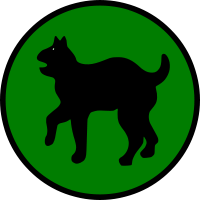81st Infantry Division (United States)
| 81st Infantry Division | |
|---|---|
|
81st Infantry Division shoulder sleeve insignia | |
| Active |
1917–19 1942–46 |
| Country |
|
| Branch |
|
| Type | Infantry |
| Size | Division |
| Nickname | "Wildcat" (special designation)[1] |
| Motto | "Wildcats never quit" |
| Engagements | |
| US infantry divisions (1939–present) | |
|---|---|
| Previous | Next |
| 80th Training Command (Army Reserve) | 82nd Airborne Division |
The 81st Infantry Division ("Wildcat"[1]) was a unit of the United States Army in World War I and World War II.
The 81st Regional Support Command continues to use the same shoulder sleeve insignia of the 81st Infantry Division. According to the U.S. Army Center of Military History, the lineage of TO&E units can not be perpetuated by TDA units; however, Army Reserve commands, Regional Support commands and others have been allowed to wear the shoulder sleeve insignia of like-numbered divisions of an earlier era.
World War I
- Activated: September 1917. Camp Jackson, South Carolina.
- Overseas: August 1918.
- Major Operations: Meuse-Argonne, Alsace-Lorraine.
- Casualties: Total-1,104 (KIA-195, WIA-909).
- Commanders: Brig. Gen. Charles H. Barth (28 August 1917), Maj. Gen. Charles J. Bailey (8 October 1917), Brig. Gen. Charles H. Barth (24 November 1917), Brig. Gen. George W. McIver (28 December 1917), Maj. Gen. Charles J. Bailey (11 March 1918), Brig. Gen. George W. McIver (19 May 1918), Brig. Gen. Munroe McFarland (24 May 1918), Maj. Gen. Charles J. Bailey (30 May 1918), Brig. Gen. George W. McIver (9 June 1918), Maj. Gen. Charles J. Bailey (3 July 1918).
- Inactivated at Hoboken, New Jersey on 11 June 1919.
World War II
- Activated: 15 June 1942, Camp Rucker, Alabama.
- Overseas: 3 July 1944.
- Campaigns: Western Pacific, South Philippines.
- Days of combat: 166.
- Awards: DSC-7 ; DSM-2 ; SS-281; LM-7; SM-40 ; BSM-658 ; AM-15.
- Commanders: Maj. Gen. Gustave H. Franke (June–August 1942), Maj. Gen. Paul J. Mueller (August 1942 to inactivation).
- Inactivated: 30 January 1946 in Japan.
Combat chronicle
The 81st Infantry Division landed in Hawaii, 11 June-8 July 1944. The division minus RCT 323 invaded Angaur Island in the Palau group, as part of the Palau Islands campaign 17 September, and pushed through to the western shore in a quick movement, cutting the island in half. The enemy was driven into isolated pockets and mopping-up operations began on 20 September. RCT 321, attached to the 1st Marine Division, went into action on Peleliu Island in the Palaus and assisted in splitting defense forces and isolating them in mountainous areas in the central part of the island. The team aided in mopping up Ngesebus Island and capturing Kongauru and Garakayo Islands. RCT 323 under naval task force command occupied the Ulithi atoll, 21–23 September 1944. Elements of the team landed on Ngulu Atoll and destroyed enemy personnel and installations, 16 October, completing the outflanking of the enemy base at Yap. On 18 October, RCT 323 left to rejoin the 81st on Peleliu, which assumed command of all troops on that island and Angaur, 20 October 1944. Resistance was ended on Peleliu, 27 November. Between 4 November 1944 and 1 January 1945, the division seized Pulo Anna Island, Kyangel Atoll, and Pais Island. The 81st left in increments from 1 January to 8 February for New Caledonia for rehabilitation and training. The division arrived in Leyte on 17 May 1945, and after a period of training participated in mopping-up operations in the northwest part of the island, 21 July 1945 to 12 August 1945. After rest and training, the 81st moved to Japan, 18 September, and performed occupation duties in Aomori Prefecture until inactivation.
General
- Nickname: Wildcat Division.
- Slogan: Wildcats Never Quit.
- Shoulder patch: A black wildcat on a black bordered olive drab disk.
The first division unit patch ever used by the Army was for the 81st Infantry Division. This unit trained at Fort Jackson, S.C., near Wildcat Creek. They created patches so they could identify each other quickly in combat. When the Wildcats went overseas in August 1918 to join the Allied Expeditionary Force in France, they wore this unusual, and then unauthorized, patch. Other units protested the shoulder patch idea and the dispute finally came to the attention of General John J. Pershing. General Pershing, however, approved the Wildcat trademark and the esprit de corps of the division and suggested the other army divisions adopt patches.[2][3]
References
![]() This article incorporates public domain material from the United States Army Center of Military History document "The Army Almanac: A Book of Facts Concerning the Army of the United States U.S. Government Printing Office, 1950 reproduced".
This article incorporates public domain material from the United States Army Center of Military History document "The Army Almanac: A Book of Facts Concerning the Army of the United States U.S. Government Printing Office, 1950 reproduced".
- ↑ 1.0 1.1 "Special Unit Designations". United States Army Center of Military History. 21 April 2010. Archived from the original on 9 July 2010. Retrieved 9 July 2010.
- ↑ Pride important for US soldiers, by Lee Berry, Univ of Mississippi, www.thedmonline.com .
- ↑ "History of the 81st United States Army Reserve Command 1917–1975" prepared by 317th Military History Detachment.
